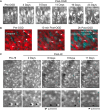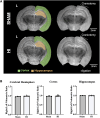Ongoing loss of viable neurons for weeks after mild hypoxia-ischaemia
- PMID: 40297712
- PMCID: PMC12034461
- DOI: 10.1093/braincomms/fcaf153
Ongoing loss of viable neurons for weeks after mild hypoxia-ischaemia
Abstract
Mild hypoxic-ischaemic encephalopathy is common in neonates, and there are no evidence-based therapies. By school age, 30-40% of those patients experience adverse neurodevelopmental outcomes. The nature and progression of mild injury is poorly understood. We studied the evolution of mild perinatal brain injury using longitudinal two-photon imaging of transgenic fluorescent calcium-sensitive and insensitive proteins to provide a novel readout of neuronal viability and activity at cellular resolution in vitro and in vivo. In vitro, perinatal organotypic hippocampal cultures underwent 15-20 min of oxygen-glucose deprivation. In vivo, mild hypoxia-ischaemia was completed at post-natal day 10 with carotid ligation and 15 min of hypoxia (FiO2, 0.08). Consistent with a mild injury, minimal immediate neuronal death was seen in vitro or in vivo, and there was no volumetric evidence of injury by ex vivo MRI 2.5 weeks after injury (n = 3 pups/group). However, in both the hippocampus and neocortex, these mild injuries resulted in delayed and progressive neuronal loss by the second week after injury compared to controls; measured by fluorophore quenching (n = 6 slices/group in vitro, P < 0.001; n = 8 pups/group in vivo, P < 0.01). Mild hypoxia-ischaemia transiently suppressed cortical network calcium activity in vivo for over 2 h after injury (versus sham, n = 13 pups/group; P < 0.01). No post-injury seizures were seen. By 24 h, network activity fully recovered, and there was no disruption in the development of normal cortical activity for 11 days (n = 8 pups/group). The participation in network activity of individual neurons destined to die in vivo was indistinguishable from those that survived up to 4 days post-injury (n = 8 pups/group). Despite a lack of significant immediate neuronal death and only transient disruptions of network activity, mild perinatal brain injury resulted in a delayed and progressive increase of neuronal death in the hippocampus and neocortex. Neurons that died late were functioning normally for days after injury, suggesting a new pathophysiology of neuronal death after mild injury. Critically, the neurons destined to die late demonstrated multiple biomarkers of viability long after mild injury, suggesting their later death may be modified with neuroprotective interventions.
Keywords: GCaMP; mild hypoxic-ischaemic injury; neocortex; network; neuronal death.
© The Author(s) 2025. Published by Oxford University Press on behalf of the Guarantors of Brain.
Conflict of interest statement
The authors report no competing interests.
Figures








Update of
-
Ongoing loss of viable neurons for weeks after mild perinatal hypoxia-ischemia.bioRxiv [Preprint]. 2024 Dec 20:2024.12.19.629457. doi: 10.1101/2024.12.19.629457. bioRxiv. 2024. Update in: Brain Commun. 2025 Apr 18;7(2):fcaf153. doi: 10.1093/braincomms/fcaf153. PMID: 39763962 Free PMC article. Updated. Preprint.
Similar articles
-
Ongoing loss of viable neurons for weeks after mild perinatal hypoxia-ischemia.bioRxiv [Preprint]. 2024 Dec 20:2024.12.19.629457. doi: 10.1101/2024.12.19.629457. bioRxiv. 2024. Update in: Brain Commun. 2025 Apr 18;7(2):fcaf153. doi: 10.1093/braincomms/fcaf153. PMID: 39763962 Free PMC article. Updated. Preprint.
-
Methods to induce primary and secondary traumatic damage in organotypic hippocampal slice cultures.Brain Res Brain Res Protoc. 2000 Apr;5(2):153-8. doi: 10.1016/s1385-299x(00)00007-6. Brain Res Brain Res Protoc. 2000. PMID: 10775835
-
The neuroprotective actions of hypoxic preconditioning and postconditioning in a neonatal rat model of hypoxic-ischemic brain injury.Brain Res. 2013 Mar 1;1498:1-8. doi: 10.1016/j.brainres.2012.12.026. Epub 2012 Dec 27. Brain Res. 2013. PMID: 23274537
-
The role of glutamate receptor maturation in perinatal seizures and brain injury.Int J Dev Neurosci. 2002 Jun-Aug;20(3-5):339-47. doi: 10.1016/s0736-5748(02)00012-6. Int J Dev Neurosci. 2002. PMID: 12175872 Review.
-
Role of TRPM7 in cerebral ischaemia and hypoxia.J Physiol. 2017 May 15;595(10):3077-3083. doi: 10.1113/JP273709. Epub 2017 Feb 8. J Physiol. 2017. PMID: 27891609 Free PMC article. Review.
References
-
- Kurinczuk JJ, White-Koning M, Badawi N. Epidemiology of neonatal encephalopathy and hypoxic-ischaemic encephalopathy. Early Hum Dev. 2010;86(6):329–338. - PubMed
-
- Robertson CMT, Finer NN, Grace MGA. School performance of survivors of neonatal encephalopathy associated with birth asphyxia at term. J Pediatr. 1989;114(5):753–760. - PubMed
-
- Sarnat HB, Sarnat MS. Neonatal encephalopathy following fetal distress. JAMA Neurol Arch. 1976;33:696–705. - PubMed
Grants and funding
LinkOut - more resources
Full Text Sources
